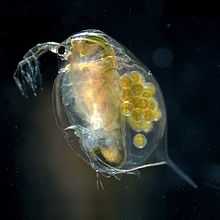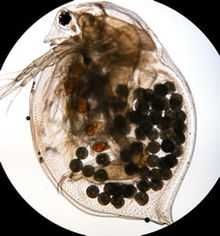Daphnia magna
| Daphnia magna | |
|---|---|
 | |
| Daphnia magna - female adult | |
| Scientific classification | |
| Kingdom: | Animalia |
| Phylum: | Arthropoda |
| Subphylum: | Crustacea |
| Class: | Branchiopoda |
| Order: | Cladocera |
| Family: | Daphniidae |
| Genus: | Daphnia |
| Species: | D. magna |
| Binomial name | |
| Daphnia magna Straus, 1820 [1] | |
Daphnia magna is a species of Daphnia (a cladoceran freshwater water flea) which is native to northern and western North America, Eurasia and some regions of Africa.
Laboratory animal
Domesticated, it is widely used as a laboratory animal for testing ecotoxicity starting with Einar Naumann in 1934.[2] As Anderson stated in 1944:[3]
The use of Daphnia magna as an experimental animal for such purposes is advantageous in many respects. Daphnids are small, reaching a size of five mm, so that a great many can be reared in a small space. They have a relatively short life span, which reaches a maximum of about two months when they are reared at 25°C. Daphnids are easy to culture, requiring only water containing bacteria or their equivalent for food. They can be grown individually in small bottles or in mass culture in large aquaria. They mature early, giving birth to young within their first week of life. After their first brood, they give rise to new broods every two or three days throughout the remainder of their lives. An average of twenty or more young may be produced in each brood. Each female who lives to a ripe old age can bear four hundred or more offspring. Again, all the young from one female are genetically like the mother if produced parthenogenically, and reproduction can be limited to parthenogenesis if the proper conditions are maintained. Further, daphnids are representatives of a class of animals that serve as food for many fish, especially while the fish are young. Fish do not remain in water where their food supply has been depleted. Daphnids would be affected if there was something toxic added to the water, therefore fish would leave and the Daphnia would die. For these reasons Daphnia prove satisfactory for testing on.
D. magna is specified to be used in the OECD Guidelines for the Testing of Chemicals, Tests No. 202 "Daphnia sp., Acute Immobilisation Test",[4] and Test No. 211 "Daphnia magna Reproduction Test".[5] Test No. 202 is a 48 hour acute toxicity study, where young Daphnia are exposed to varying concentrations of the substance under test and the EC50 determined. Other Daphnia species than D. magna may occasionally be used, but labs mostly use D. magna as standard.
Test No. 211 is a 21-day chronic toxicity test, at the end of which, the total number of living offspring produced per parent animal alive at the end of the test is assessed, to determine the lowest observed effect concentration of the test substance.
Effect of Salt
As NaCl concentration increases, the D. magna heartbeat increases to a certain point and then decreases.The reason why is described below: The heart has a natural pacemaker. The sinoatrial (SA) node generates electrical impulses, which regulate the heartbeat by way of nerve cells. Two sets of nerves do the job: the first speeds up the SA node, and the second slows the pacemaker. Each nerve cell has an optimal ratio of Na+ of 15/150 (inside/outside concentration). When the Na+ enters the heart, the sodium encounters the pacemaker. Consequently, the first part of the SA node attempts to pump more Na+ in to maintain equilibrium. When the concentration is high enough, the nerves reach the action potential threshold, the action (in this case speeding up the heart rate) climbs steeply, until the cells die of hyper tonicity. The same effect takes place in the second set of nerve cells except they slow the heart, until they die and the heart stops.
Other uses

| Wikimedia Commons has media related to Daphnia magna. |
As it is easy to culture, D. magna is widely grown as fish food.
A recent study has postulated that Daphnia magna eats the spores of the devastating chytrid fungus Batrachochytrium dendrobatidis.[6]
References
- ↑ "Daphnia magna". Integrated Taxonomic Information System.
- ↑ Naumann, Einar (1934). "Über die Anwendung von Daphnia magna Straus als Versuchstier zur experimentellen Klarlegung der Lebensverhältnisse im Wasser". Internationale Revue der gesamten Hydrobiologie und Hydrographie 31 (1): 421–431. doi:10.1002/iroh.19340310126.
- ↑ Bertil G. Anderson (1944). "The Toxicity Thresholds of Various Substances Found in Industrial Wastes as Determined by the Use of Daphnia magna". Sewage Works Journal 16 (6): 1156–1165. JSTOR 25029937.
- ↑ "Test No. 202: Daphnia sp. Acute Immobilisation Test". OECD Guidelines for the Testing of Chemicals. Organisation for Economic Co-operation and Development. Retrieved July 4, 2013.
- ↑ "Test No. 211: Daphnia magna Reproduction Test". OECD Guidelines for the Testing of Chemicals. Organisation for Economic Co-operation and Development. Retrieved July 4, 2013.
- ↑ Buck, Julia; Truong, Lisa; Blaustein, Andrew (2011). "Predation by zooplankton on Batrachochytrium dendrobatidis: biological control of the deadly amphibian chytrid fungus?". Biodiversity and Conservation 20 (14): 3549–3553. doi:10.1007/s10531-011-0147-4.